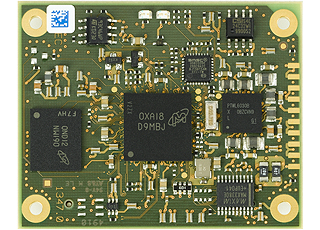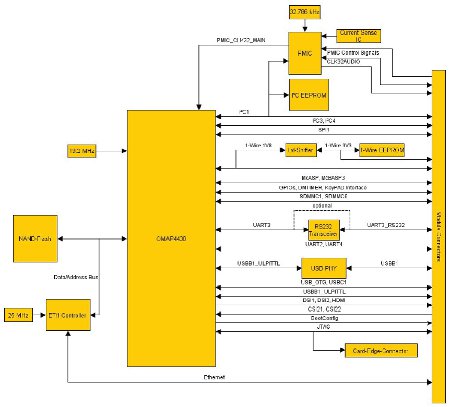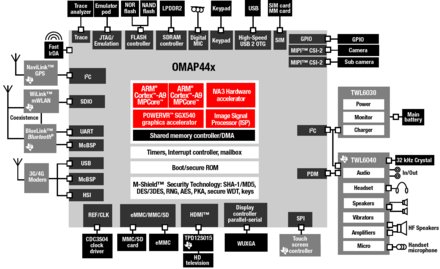First OMAP4 module appears
Apr 5, 2011 — by Eric Brown — from the LinuxDevices Archive — 12 viewsPhytec announced what it claims is the first computer module based on the Texas Instruments OMAP4430 system-on-chip (SoC). The PhyCore-OMAP4430 clocks the SoC's dual ARM Cortex-A9 cores to 1GHz, measures 1.6 x 2.0 inches (41 x 51 mm), offers up to 1GB LPDDR2 RAM and 1GB NAND flash, provides Ethernet, USB, and I2C connectivity, and draws only three Watts.
In February, Phytec announced a PhyCore-AM3517 module based on the Texas Instruments (TI) Cortex-A8-based AM3517 SoC, and previously shipped one using the Cortex-A8-based OMAP3530. The company is now moving up to TI's OMAP4430 — see later in this story for background — with the PhyCore-OMAP4430, targeting high-end devices that offer wireless connectivity for industrial, medical, and video or imaging solutions.

PhyCore-OMAP4430 SOM
The module comes with a 10/100 Ethernet controller, as well as USB host and OTG interfaces, plus a variety of other interfaces including RS-232, I2C, and SPI (see spec list below). A camera interface is said to support the OMAP4430's ability to drive 20-megapixel single cameras and dual five-megapixel cameras for 3D imaging.
The module sips only 3 Watts, and operates at a -40 to 185 deg. F (-40 to 85 deg. C) temperature range, says the company.

PhyCore-OMAP4430 SOM block diagram
(Click to enlarge)
Features and specifications listed for the PhyCore-OMAP4430 SOM include:
- Processor — TI OMAP4430 with dual Cortex-A9 cores @ 1GHz and PowerVR SGX540 3D accelerator, 720p stereoscopic 3D, and IVA 3 video accelerator (1080p encode/decoder)
- Memory — up to 1GB LPDDR2 RAM; up to 1GB NAND flash
- Flash expansion — 2 x SDIO/MMC interfaces
- Networking — 10/100 Ethernet controller
- Other I/O:
- USB 2.0 high-speed host
- USB 2.0 OTG
- ULPI for connectivity to an external USB Phy
- 4 x UARTS
- RS-232
- 3 x I2C
- I2S
- 2 x SPI
- 2 x DSI (display serial interface)
- DVI/HDMI
- PWM
- camera
- keypad
- JTAG
- Power — 3.3V; 3 Watt consumption
- Operating temperature — -40 to 185 deg. F (-40 to 85 deg. C)
- Dimensions — 1.6 x 2.0 inches (41 x 51mm)
- Operating System — Linux (Android-ready), Windows Embedded Compact 7
A development kit will be available for the PhyCore-OMAP4430 that includes the module, a carrier board, an optional LCD, and other accessories. Developers can choose from Windows Embedded Compact 7 or Linux to be pre-installed on the SOM, with the latter said to support Android implementations as well. In addition, Phytec offers a full range of design services, including embedded hardware design, operating system adaptation, and complete turnkey designs.
Stated Bodo Huber, chief technology officer of Phytec, "Our deployment-ready hardware, in combination with production-ready Windows Compact 7 and Linux BSPs, will enable general market developers to reach their product goals with minimal development time."
Background
The OMAP4330 was announced as the first ARM Cortex-A9 SoC back in Feb. 2009, along with the faster, but similarly dual-core OMAP4440. It received a speed upgrade in December of last year to 1GHz, while the OMAP4440 was boosted to 1.5GHz.
OMAP44x function block diagram
(Click to enlarge)
In February, TI said the SoCs were sampling, and it announced an OMAP4-based Blaze smartphone reference design developed for TI by SVTronics. About the same time, LG announced an Optimus 3D Android phone based on the OMAP4.
The PhyCore-OMAP4430 SOM does indeed appear to be the first module based on the OMAP4 processors. However, in October, Digi-key began shipping a PandaBoard open platform Linux/Android development board based on the OMAP4430, selling for only $174.
The OMAP4430 features hardware accelerated 2D and 3D graphics and 1080p HD video playback. The latest version offered here adds support for dual (stereoscopic) five megapixel video cameras, enabling 3D movie recording at up to 720p.
Availability
The PhyCore-OMAP4430 Rapid Development Kits will be available from Phytec in the second quarter for $549. More information may be found at Phytec's PhyCore-OMAP4430 SOM page.
This article was originally published on LinuxDevices.com and has been donated to the open source community by QuinStreet Inc. Please visit LinuxToday.com for up-to-date news and articles about Linux and open source.
